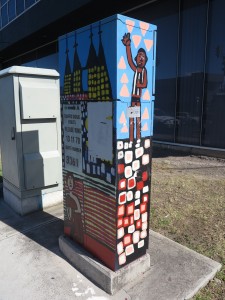Make the next-generation broadband infrastructure beautiful

This is how you can make those cabinets part of the street fabric
Whenever any new infrastructure is laid down, there is an increase in the number of street cabinets that will appear as the result of this infrastructure. This is more so with next-generation broadband especially if the service is based around fibre-copper technologies, implements active components or is prepared to do so.
But these cabinets attract a “not in my backyard” comments or activism from local residents or neighbourhoods because of them looking ugly and becoming a surface for the local graffiti artists and gangs to scrawl their “tags” on to. Similarly, the street cabinets can effectively become obstacles in their own right.
There can be something better done about this. One way would be to encourage or commission local artists to paint these cabinets with designs that complement the neighbourbood or a local effort. They then look beautiful in their own right rather than as ugly boxes. Such paintwork can be directly applied or painted on to a vinyl “skin” or “wrap” which is applied to the box. The latter approach can apply to seasonal efforts like Christmas decorations or advertising campaigns if the “skin” can be removed.
Another approach would be to design the street cabinets to be integrated to other street furniture. This would work well if there isn’t a need to provide maintenance access or equipment ventilation from all sides of the cabinet. Examples of this could include a cabinet that is integrated in to a street bench or litter bin. Simply an infrastructure cabinet could benefit from being equipped with a closed rail especially if it is located close to a café or bar with a street dining area. This is because it can be used as a hitching-post for a patron’s dog or bicycle.
What needs to be done to prevent the NIMBY attitude concerning next-generation broadband and similar infrastructure in urban areas is to look at ways to integrate the cabinets in to the neighbourhood area’s fabric so they effectively blend in.


![US Flag By Dbenbenn, Zscout370, Jacobolus, Indolences, Technion. [Public domain], via Wikimedia Commons](https://homenetworking01.info/wp-content/uploads/2014/08/Flag_of_the_United_States.svg_-300x157.png)
![Epping Forest © Copyright tim and licensed for reuse under this Creative Commons Licence tim [CC BY-SA 2.0 (http://creativecommons.org/licenses/by-sa/2.0)], via Wikimedia Commons](https://homenetworking01.info/wp-content/uploads/2015/07/geograph-096109-by-tim-300x225.jpg)

![York UK aerial view courtesy of DACP [CC BY-SA 2.0 (http://creativecommons.org/licenses/by-sa/2.0)], via Wikimedia Commons](https://homenetworking01.info/wp-content/uploads/2015/09/York_Aerial_view-300x225.jpg)


